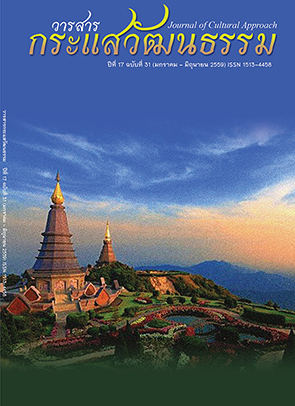การศึกษาบทเพลงของ พร ภิรมย์ และการประพันธ์เพลงเถาจากทำนองเพลงของพรภิรมย์
Main Article Content
บทคัดย่อ
งานวิจัยเล่มนี้มีจุดมุ่งหมายในการศึกษาคือ ศึกษาชีวประวัติและบทเพลงของ พร ภิรมย์ และศึกษาการประพันธ์เพลงเถาจากทำนองเพลงของ พร ภิรมย์ และประพันธ์เพลงเถาจากทำนอง เพลงของ พร ภิรมย์ งานวิจัยเล่มนี้มีจุดมุ่งหมายในการศึกษาคือ ศึกษาชีวประวัติและบทเพลงของ พร ภิรมย์ และศึกษาการประพันธ์เพลงเถาจากทำนองเพลงของ พร ภิรมย์ และประพันธ์เพลงเถาจากทำนอง เพลงของ พร ภิรมย์
บทเพลงที่ทำการวิจัยมี 6 บทเพลง จำแนกเป็นเพลงลูกทุ่ง 4 เพลง ได้แก่ 1. เพลงบัวตูมบัวบาน 2. เพลงน้ำตาลาไทร 3. เพลงกระท่อมทองกวาว 4. เพลงจำใจจากเพลงราชนิเกลิง 1 เพลงได้แก่ เพลงดาวลูกไก่ท่อน 1 และท่อน 2 เพลงแหล่ 1 เพลงได้แก่ เพลงวังแม่ลูกอ่อน ท่อน 1 และท่อน 2 ส่วนการศึกษาเพลงเถาที่ประพันธ์จากทำนองเพลงของ พร ภิรมย์ ได้แก่เพลงทองกวาวเถา และเพลงบัวตูมบัวบาน เถาเพลงของ พร ภิรมย์ ที่นำมาประพันธ์เป็นเพลงเถาคือ เพลงจำใจจาก
ผลจากการศึกษาทราบว่า พร ภิรมย์ ชื่อจริงคือนายบุญสม มีสมวงษ์ เป็นบุตรคนโตของพี่น้องร่วมบิดามารดา 11 คน พร ภิรมย์ สมรสกับนางระเบียบ ภาคนาม มีบุตรด้วยกัน 1 คน ชื่อนายรังสรรค์ มีสมวงษ์ พร ภิรมย์มีความสามารถหลายด้านทั้งการแสดงลิเก การพากย์หนัง การร้องเพลง และการแต่งเนื้อร้องและการแต่งทำนองเพลง โดยเฉพาะอย่างยิ่งการร้องเพลงและการประพันธ์เพลง โดยได้รับรางวัลพระราชทานแผ่นเสียงทองคำ พ.ศ. 2509 เพลงบัวตูมบัวบานและเพลงดาวลูกไก่ ซึ่งพร ภิรมย์แต่งและขับร้องเอง ปัจจุบันพร ภิรมย์อุปสมบทอยู่ที่วัดรัตนชัย (วัดจีน) จังหวัดพระนครศรีอยุธยา
บทประพันธ์ของท่านที่เป็นเพลงลูกทุ่ง มีทั้งเพลงที่เป็นเอกบทและทวิบท ลักษณะคำประพันธ์เป็นกลอนแปดและกลอนตลาด มีการใช้ทำนองหลักและพัฒนาเป็นแนวทำนองใหม่ ส่วนเพลงราชนิเกลิงและเพลงแหล่เป็นเพลงท่อนเดียว ลักษณะทำนองเป็นประเภทซ้ำทำนอง แต่เนื้อเพลงเปลี่ยนไป คำประพันธ์เป็นประเภทกลอนหัวเดียว ใช้เครื่องดนตรีไทยบรรเลงประกอบ
การศึกษาเพลงทองกวาวเถาและเพลงบัวตูมบัวบานเถาซึ่งครูสำราญ เกิดผล (ศิลปินแห่งชาติ) ประพันธ์จากทำนองเพลงกระท่อมทางกวาวและเพลงบัวตูมบัวบานของพร ภิรมย์นั้น ครูสำราญ เกิดผล ใช้หลักการประพันธ์เพลงเถาโดยยึดทำนองเดิมเป็นทำนองสองชั้นและใช้หลัก การขยายเพลงและตัดเพลงโดยยึกลูกตกท้ายหน้าทับเป็นสำคัญ
การประพันธ์เพลงเถาจากทำนองเพลงของพร ภิรมย์ ผู้วิจัยได้นำทำนองเพลงจำใจจาก มาเป็นทำนองชั้นเดียวแล้วแต่งขยายขึ้นเป็นสองชั้นและสามชั้น โดยให้ลูกตกกลางหน้าทัยและท้ายหน้าทับตรงกันทั้งหมด เพื่อให้ทำนองเพลงมีความสัมพันธ์กันตลอดทั้งเถา และตั้งชื่อเพลงว่า "ภิรมย์พร" เถา
Article Details
Proposed Creative Commons Copyright Notices
1. Proposed Policy for Journals That Offer Open Access
Authors who publish with this journal agree to the following terms:
- Authors retain copyright and grant the journal right of first publication with the work simultaneously licensed under a Creative Commons Attribution License that allows others to share the work with an acknowledgement of the work's authorship and initial publication in this journal.
- Authors are able to enter into separate, additional contractual arrangements for the non-exclusive distribution of the journal's published version of the work (e.g., post it to an institutional repository or publish it in a book), with an acknowledgement of its initial publication in this journal.
- Authors are permitted and encouraged to post their work online (e.g., in institutional repositories or on their website) prior to and during the submission process, as it can lead to productive exchanges, as well as earlier and greater citation of published work (See The Effect of Open Access).
Proposed Policy for Journals That Offer Delayed Open Access
Authors who publish with this journal agree to the following terms:
- Authors retain copyright and grant the journal right of first publication, with the work [SPECIFY PERIOD OF TIME] after publication simultaneously licensed under a Creative Commons Attribution License that allows others to share the work with an acknowledgement of the work's authorship and initial publication in this journal.
- Authors are able to enter into separate, additional contractual arrangements for the non-exclusive distribution of the journal's published version of the work (e.g., post it to an institutional repository or publish it in a book), with an acknowledgement of its initial publication in this journal.
- Authors are permitted and encouraged to post their work online (e.g., in institutional repositories or on their website) prior to and during the submission process, as it can lead to productive exchanges, as well as earlier and greater citation of published work (See The Effect of Open Access).
เอกสารอ้างอิง
[2] Arunwong, Nitaya. (2003). A Study of Biography and Singing Methods of Ruangthong Thonglanthom. Thesis M.A. (Ethnomusicology). Bangkok : Graduate School, Srinakharinwirot University.
[3] Chaichamnan, Malinee. (1992). An Analysis of Cholatee Tharnthong’s Loog Toong Literature. Thesis M.Ed. Songkla : Graduate School, Srinakharinwirot University Songkla.
[4] Chaloempol Ngamsudhi. (n.d.). MU 102 : Rudimentary Western Music – Learning Sheets. Sangeet Niyom. (n.p.).
[5] Charoensuk, Sukree. (1990). Analytical Course of Loog Toong Music and Folk Music in the Path of Thai Loog Toong Music. Bangkok : National Office of Culture.
[6] Dusadee Phanomyong. (1996). Weaving Dreams Together with Songs: Let’s Sing Together. Revised 2nd Edition. Bangkok : Baan Pleng Press.
[9] HRH Princess Maha Chakri Sirindhorn. (1990). Loog Toong and Thai Music. Arts and Culture. (n.p.).
[10] Intarasunanont, Kanchana. (1997). Thai traditional Singing Techniques. Deparment of Thai Music, Faculty of Fine Arts. Bangkok : I.S. Printing House.
[11] Khamhaeng, Winij. (1999). An Analysis of Cowboy-Loog Toong Songs of Petchr Phanomroong in Loog Toong Siang Thong Series. Thesis M.A. (Ethnomusicology). Bangkok : Graduate School, Srinakharinwirot University.
[12] Krobthong, Siriporn. (2003). Development of Loog Toong Music in Thai Society. Bangkok : Pantakij Press.
[13] Mekhsornthongkham, Bupha. (1991). A Study of Thai Loog Toong Music for Improvement of Life Quality : an Analysis of Loog Toong Songs Content between 1989 – 1990. Thesis M.A. (Mass Communication). Bangkok : Graduate School, Thammasat University.
[14] Suksuwan, Laksana. (1978). Loog Toong Music Literature. Thesis M.Ed. (Thai Language). Bangkok : Graduate School Srinakharinwirot University.
[15] Wisuttipat, Manop. (1990). Thai Music Analysis. Memorial Book of the 22nd University Thai Music Festival, Srinakharinwirot University. Bangkok : Chuanpim Press


